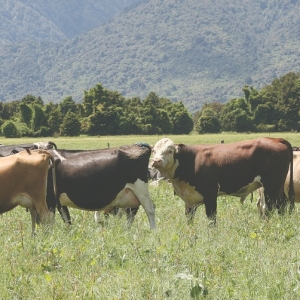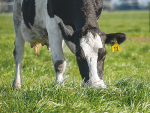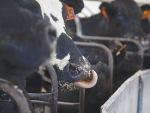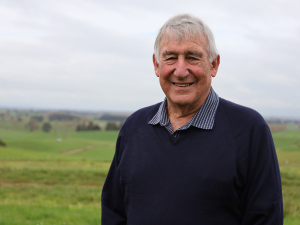“I just don’t like them,” Sandra Dymock told the local dairy discussion group at a field day on the property. “We’ll probably regret it a little [in production] but I’m going to stick with it.”
This season’s calving, from August 11, got off to a good start and mean calving date was early September but a tail of 15-20 cows “seemed to take forever”, so this season they’ve “got hard” on late calving cows and pulled the bull out January 22.
As for carry-overs, their time was up before Christmas. “If they’re empty, they’re gone,” noted Tammy. Udders and feet are the other points they’re making cull decisions on this year, “without worrying about production.”
To allow more attention to be paid to getting cows in calf they decided not to herd test. “You’ve got to focus on something and getting cows in calf is it,” said Sandra.
Every day they watched for heat activity in the paddock and heat detectors were applied. However, many detectors were activated on animals not in heat for some reason, so they reverted to tail painting. Non-cyclers were put into one mob and bulls used to aid heat detection, followed up by AB to “beat the bull.”
At the December discussion group Tammy noted the bulls were “hammering the pink tails” and appeared to have picked up all 30 non-cyclers from the 390-cow herd. “Overall I’m pretty happy. It’s a lot better than last year.”
That result’s despite a difficult pasture season: early spring weather was kind but late September and October were unseasonably wet, even by West Coast standards.
As Dairy NZ consulting officer Ross Bishop recalls, “there was a reasonable amount of feed about but utilising it without doing too much damage was the difficulty.”
In the run-up to Christmas, when the local Dairy NZ-facilitated discussion group met on the Dymock’s farm, the legacy of that was still evident in the paddocks. “The paddocks are like hay paddocks,” Kelvin Dymock told the discussion group. “It looks like there’s a lot in there but there’s a lot they’re leaving behind.”
About 10% of the farm (18ha) was shut up for silage with the cows on “about” a 27-day rotation – “about” because as Kelvin put it, “the eye-ometer” could overrule the calendar if need be to keep quality feed in front of the herd.
The Dymock’s were far from alone in their battle with pasture quality. “It’s just all stalk, that’s the problem at the moment,” noted another discussion group participant.
Whether the Lincoln University approach of topping ahead of the herd to encourage cows to be less choosy and maintain pasture quality in the next round would work in the much wetter West Coast environment was a point of debate. Another group member noted quality was proving much easier to maintain on reseeds.
“I’m just pulling the topper out and will be renovating as much of the farm as I can.”
Kelvin said that’s easier said than done on much of their farm. “You can pick up 30t of rocks and hardly know you’ve been there.”
In respect of production, this season’s target is 360kgMS/cow, after doing 320kg/cow and 620kg/ha in 2011/12, and 330kg/cow and 710kg/ha in 2010/11, their first season with the Whataroa farm.
Last week they were on course for that 360kg/cow target, with the help of 1.2kg/cow/day of meal. But even 360kg/cow is still short of the 400kg/cow the real estate agent told them was the norm for the area when they first looked at the farm, not that they ever took that figure too seriously. “When we mentioned that to some of the neighbours we just got these looks!”


















